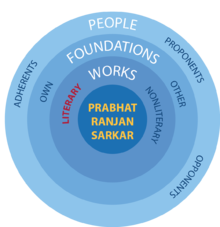The Tantric Definition of Yoga: Difference between revisions
(Created page with "{{Infobox discourse | title = <!-- Write the name of the title -->The Tantric Definition of Yoga | image = <!--Write image name eg. Example.jpg, do not include "File:" --> | c...") |
m (Small corrections (mostly grammar and formatting)) |
||
| Line 10: | Line 10: | ||
| also known as = <!--Other names --> | | also known as = <!--Other names --> | ||
| language = English | | language = English | ||
| topic = <!-- Topic -->Mental propensities have to be guided to the | | topic = <!-- Topic -->Mental propensities have to be guided to the supreme abode | ||
| event = <!-- Event, if any --> | | event = <!-- Event, if any --> | ||
| included in = [[Ananda Vacanamrtam Part 3]] | | included in = [[Ananda Vacanamrtam Part 3]] | ||
| Line 18: | Line 18: | ||
== Synopsis == | == Synopsis == | ||
{{Quote box|width=360px|bgcolor=|align=left|quoted=1|salign=right|quote=According to Tantra, the unification of the jiivátmá with Paramátmá means yoga. After withdrawing the mental propensities, they are to be guided towards the Supreme Entity. Then alone will the withdrawal be final. Only by guiding these withdrawn mental propensities towards the Supreme Cognition can the total unification of the jiivátmá with Paramátmá be possible, and this is yoga.|source=Shrii Shrii Anandamurti}} | {{Quote box|width=360px|bgcolor=|align=left|quoted=1|salign=right|quote=According to Tantra, the unification of the jiivátmá with Paramátmá means yoga. After withdrawing the mental propensities, they are to be guided towards the Supreme Entity. Then alone will the withdrawal be final. Only by guiding these withdrawn mental propensities towards the Supreme Cognition can the total unification of the jiivátmá with Paramátmá be possible, and this is yoga.|source=Shrii Shrii Anandamurti}} | ||
Anandamurti starts the discourse by saying that in the | Anandamurti starts the discourse by saying that in the [[Samskrta|Saḿskrta]] language significance is given to the root of the verb and to its everyday colloquialism. When the verb's root changes, the word takes on a new meaning. Anandamurti then explains that several interpretations of the word ''yoga'' exist. The first is ''addition''. Second, and also the tantric interpretation, is ''unification'', as in combining sugar and water. The third is Maharshi Patanjali's ''Yogashcittavrttirnirodhah'' (suspension of all mental propensities). Anandamurti goes on explaining that suspended mental tendencies create disruption in the mind when not guided toward ''Paramatma'' (Supreme Cognition). Only when properly directed is complete unification possible.<ref name="AV3"/> | ||
== References == | == References == | ||
Revision as of 05:37, 3 April 2018
| The Tantric Definition of Yoga | |
|---|---|
| Speaker | Shrii Shrii Anandamurti |
| Date | 1978 October 2 |
| Time | Unknown |
| Place | Patna, India |
| Language | English |
| Topic | Mental propensities have to be guided to the supreme abode |
| Included in | Ananda Vacanamrtam Part 3 |
| Location in Sarkarverse | |
The Tantric Definition of Yoga is a discourse given by Shrii Shrii Anandamurti on 1978 October 2 in Patna, India. This discourse is the second chapter of Ananda Vacanamrtam Part 3.[1]
Synopsis
According to Tantra, the unification of the jiivátmá with Paramátmá means yoga. After withdrawing the mental propensities, they are to be guided towards the Supreme Entity. Then alone will the withdrawal be final. Only by guiding these withdrawn mental propensities towards the Supreme Cognition can the total unification of the jiivátmá with Paramátmá be possible, and this is yoga.
Anandamurti starts the discourse by saying that in the Saḿskrta language significance is given to the root of the verb and to its everyday colloquialism. When the verb's root changes, the word takes on a new meaning. Anandamurti then explains that several interpretations of the word yoga exist. The first is addition. Second, and also the tantric interpretation, is unification, as in combining sugar and water. The third is Maharshi Patanjali's Yogashcittavrttirnirodhah (suspension of all mental propensities). Anandamurti goes on explaining that suspended mental tendencies create disruption in the mind when not guided toward Paramatma (Supreme Cognition). Only when properly directed is complete unification possible.[1]
References
| Preceded by Can Women Attain Salvation? |
Ananda Vacanamrtam Part 3 With: The Tantric Definition of Yoga |
Succeeded by The Seven Secrets of Success |
